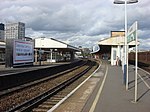Vauxhall Park
1890 establishments in EnglandParks and open spaces in the London Borough of Lambeth

Vauxhall Park is a Green Flag Award-winning municipal park in Vauxhall, South London, run by Lambeth Council. It occupies an 8.5-acre site, and was created at a cost of around £45,000, following a public campaign led by the suffragist Millicent Fawcett, the social reformer Octavia Hill and members of the Kyrle Society. The land was purchased from a local developer under the Vauxhall Park Act 1888. and the houses of Lawn Terrace demolished accordingly. The new park was formally opened in 1890 by the Prince of Wales.
Excerpt from the Wikipedia article Vauxhall Park (License: CC BY-SA 3.0, Authors, Images).Vauxhall Park
Rita Road, London Vauxhall (London Borough of Lambeth)
Geographical coordinates (GPS) Address Nearby Places Show on map
Geographical coordinates (GPS)
| Latitude | Longitude |
|---|---|
| N 51.483 ° | E -0.122 ° |
Address
Lavender Garden
Rita Road
SW8 1JP London, Vauxhall (London Borough of Lambeth)
England, United Kingdom
Open on Google Maps









